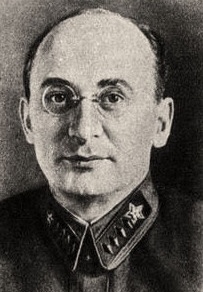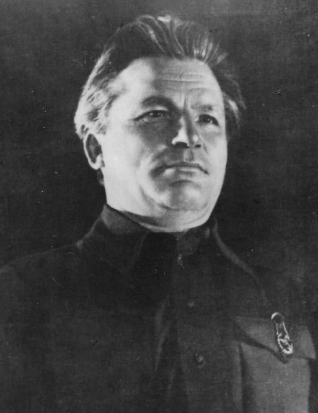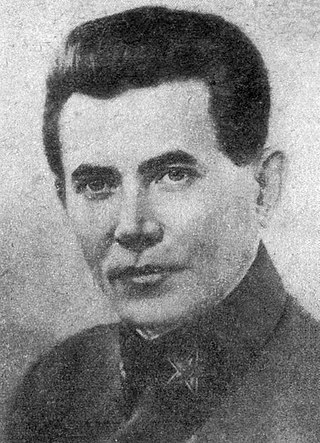Related Research Articles

Lavrentiy Pavlovich Beria was a Georgian Bolshevik and Soviet politician, Marshal of the Soviet Union and its state security administrator and chief, and chief of the People's Commissariat for Internal Affairs (NKVD) under Joseph Stalin during the Second World War, and promoted to deputy premier under Stalin in 1941. He officially joined the Politburo in 1946. Beria was the longest-serving and most influential and brutal of Stalin's secret police chiefs, wielding his most substantial influence during and after the war. Following the Soviet invasion of Poland in 1939, he was responsible for organising purges such as the Katyn massacre of 22,000 Polish officers and officials.

Sergei Mironovich Kirov was a Russian and Soviet politician and Bolshevik revolutionary.

The Great Purge, or the Great Terror, also known as the Year of '37 and the Yezhovshchina, was Soviet General Secretary Joseph Stalin's campaign to consolidate his power over the Communist Party of the Soviet Union and Soviet state. The purges also sought to remove the remaining influence of Leon Trotsky. The term great purge, an allusion to the French Revolution's Reign of Terror, was popularized by the historian Robert Conquest in his 1968 book The Great Terror.

Genrikh Grigoryevich Yagoda was a Soviet secret police official who served as director of the NKVD, the Soviet Union's security and intelligence agency, from 1934 to 1936. Appointed by Joseph Stalin, Yagoda supervised arrests, show trials, and executions of the Old Bolsheviks Lev Kamenev and Grigory Zinoviev, climactic events of the Great Purge. Yagoda also supervised construction of the White Sea–Baltic Canal with Naftaly Frenkel, using penal labor from the gulag system, during which 12,000–25,000 laborers died.

Nikolai Ivanovich Yezhov was a Soviet secret police official under Joseph Stalin who was head of the NKVD from 1936 to 1938, during the height of the Great Purge. Yezhov organized mass arrests, torture and executions during the Great Purge, but he fell from Stalin's favour and was arrested, subsequently admitting in a confession to a range of anti-Soviet activity including "unfounded arrests" during the Purge. He was executed in 1940 along with others who were blamed for the Purge.

Andrei Aleksandrovich Zhdanov was a Soviet politician and ideologue. He has been described as the Soviet Union's "propagandist-in-chief" in the 1940s, and was responsible for developing the Soviet cultural policy, the Zhdanov Doctrine, which remained in effect until the death of Joseph Stalin. Zhdanov was considered Stalin's most likely successor but died before him.

An index of articles related to the former nation known as the Soviet Union. It covers the Soviet revolutionary period until the dissolution of the Soviet Union. This list includes topics, events, persons and other items of national significance within the Soviet Union. It does not include places within the Soviet Union, unless the place is associated with an event of national significance. This index also does not contain items related to Soviet Military History.
Leonid Vasilevich Nikolaev was the assassin of Sergei Kirov, the first secretary of the Leningrad branch of the Communist Party.

Alexander Grigoryevich Barmin, most commonly Alexander Barmine, was an officer in the Soviet Army and diplomat who fled the purges of the Joseph Stalin era for France and then United States, where he served the US government and also testified before congressional committees.
The Ryutin affair (1932) was one of the last attempts to oppose the General Secretary Joseph Stalin within the All-Union Communist Party (b).

Mikhail Petrovich Frinovsky was a Soviet secret police official who served as a deputy head of the NKVD under Nikolai Yezhov during the Great Purge.

Avel Safronovich Yenukidze was a prominent Georgian "Old Bolshevik" and, at one point, a member of the Central Committee of the All-Union Communist Party (b) in Moscow. In 1932, along with Mikhail Kalinin and Vyacheslav Molotov, Yenukidze co-signed the infamous "Law of Spikelets". In 1918 to 1935 Yenukidze served as the Secretary of the All-Russian Central Executive Committee and the Central Executive Committee of the Soviet Union.

Joseph Stalin started his career as a radical student, becoming a robber, gangster as well as an influential member and eventually the leader of the Bolshevik faction of the Russian Social Democratic Labour Party. He served as the General Secretary of the Central Committee of the Communist Party of the Soviet Union from 1922 until his death in 1953.
The Case of the Anti-Soviet "Bloc of Rightists and Trotskyites", also known as the Trial of the Twenty-One, was the last of the three public Moscow trials charging prominent Bolsheviks with espionage and treason. The Trial of the Twenty-One took place in Moscow in March 1938, towards the end of the Soviet Great Purge. The accused were tortured to extract confessions and publicly admitted their guilt during the show trial. Most of the accused, including Nikolai Bukharin, Alexei Rykov and Genrikh Yagoda, were convicted to death. All charges are considered fabricated except that Valerian Kuybyshev, Vyacheslav Menzhinsky, and Maxim Gorky might indeed be poisoned by NKVD chief Genrikh Yagoda with the assistance of "Kremlin's doctors" Pletnyov and Lev Levin, but they did it on the orders from Stalin himself.
The Moscow trials were a series of show trials held by the Soviet Union between 1936 and 1938 at the instigation of Joseph Stalin. They were nominally directed against "Trotskyists" and members of the "Right Opposition" of the Communist Party of the Soviet Union.
- The "Case of the Trotskyite–Zinovievite Terrorist Center" ;
- The "Case of the Anti-Soviet Trotskyist Center" ; and
- The "Case of the Anti-Soviet 'Bloc of Rightists and Trotskyites'".

Yefim Georgievich Yevdokimov was a Soviet politician and member of the Cheka and OGPU. He was a key figure in the Red Terror, the Great Purge and dekulakization that saw millions of people executed and deported.

Ivan Alekseyevich Akulov was a leading Russian Old Bolshevik revolutionary, Soviet official and statesman, who for a few months was nominally second in command of the political police, the OGPU.

Matvei Fyodorovich Shkiryatov was a Communist Party official and functionary who rose to power in the Soviet Union during the rule of Joseph Stalin. His entire career was spent imposing party discipline through the Central Control Commission of the Communist Party of the Soviet Union. Though far less well known than successive chiefs of the Soviet police, such as Nikolai Yezhov or Lavrentiy Beria, he was arguably as steeply involved as either of them in the repression during the Stalin years. Unlike them, he escaped arrest or public notoriety.

Ivan Vasilevich Zaporozhets was a Ukrainian Soviet security officer and official of the OGPU-NKVD who was suspected of being involved in the assassination of Sergei Kirov in Leningrad in December 1934.
The assassination of Sergei Mironovich Kirov, head of the Leningrad party organization, member of the Politburo, the Orgburo, and secretary of the Central Committee of the All-Union Communist Party of Bolsheviks, took place on December 1, 1934, in Smolny. The murder was committed by Leonid Nikolaev.
References
- 1 2 3 4 5 Andrew, Christopher M. (2018). The Secret World A History of Intelligence. Yale University Press. pp. 595–597. ISBN 9780300238440.
- 1 2 Русская Семерка (3 September 2017). "Кремлевское дело: что произошло в действительности" . Retrieved 18 December 2023.
- ↑ Getty, J. Arch and Naumov, Oleg V. (2010). The Road to Terror, Stalin and the Self-Destruction of the Bolsheviks, 1932-1939. New Haven: Yale U.P. pp. 161–79, 234–5. ISBN 978-0-300-10407-3.
{{cite book}}: CS1 maint: multiple names: authors list (link) - ↑ Lokhova, Svetlana (October 1, 2019). The Spy Who Changed History: The Untold Story of How the Soviet Union Stole America's Top Secrets. Pegasus Books. pp. preface. ISBN 9781643132143.
- ↑ Stalin, Joseph. "Address to the Graduates from the Red Army Academies". Marxists Internet Archive. Retrieved 31 March 2024.